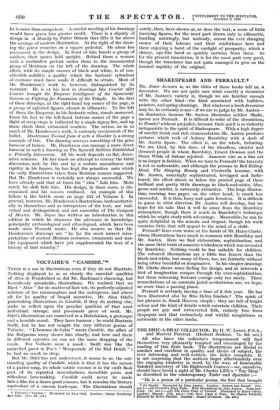THE CONQUEST OF MEXICO.t ILLUSTRATION is one of the most
dangerous ways of tampering with a book. Year after year in the bookshops we open a new edition of some favourite author and close it hurriedly, carrying away an aesthetic horror that must always afterwards revisit us at the mention of the name of that author. It is one of the rarest of all delights to find our pleasure in a book enhanced by an illustrated edition. That Mr. Henderson has achieved this with so great a book as The Conquest of Mexico is a large measure of credit to him. His illustrations are very uneven in inspiration, but his execution is nearly always competent. Drawings like Cones at Thirty-three or Examin- ation of the Cacique's Wife are sufficiently able ; they would not spoil a book, but neither would they improve it. As with an artists, it is only when Mr. Henderson has an " idea " that
• Chinese Furniture. By Herbert Cescinsky. London : Bean Bros., Ltd. (503.] t The Conquest of Mexico. By W. H. Prescott. With an Introduction by T. A, Joyce and illustrated by Keith Henderson, 4)battoiusd-Windus. [12 22. net.j
he is more than competent. A careful weeding of his drawings would have given him greater credit. There is a dignity of design in A Homily by Father Olmedo that lifts it far above the average of modern illustration. At the right of the draw- ing the priest crouches on a square pedestal. He alone has movement in the design.. In front of him kneels a group of soldiers, their spears held upright. Behind them a woman with a motionless gesture unites them to the monumental group of Mexicans on the left of the drawing. The whole effect, with its simple masses of black and white, is of con- siderable nobility, a quality which the barbaric splendour of costume must have made it difficult to attain. Most of Mr. Henderson's work is, however, distinguished by its restraint. He is at his best in drawings like Courier after Courier brought the Emperor Intelligence of the Spaniards' Success or Fighting for Possession of the Temple. In the first of these drawings, at the right-hand top corner of the page, is a group of agitated figures, almost in silhouette. To the left of them the Emperor, in his fantastic robes, stands unmoved. From his feet to the left-hand bottom corner of the page a flight of steep steps is indicated by a single zigzag line, and up them climb three exhausted couriers. The action, as in so much of Mr. Henderson's work, is curiously reminiscent of the ballet. Montezuma Turned from it with a Shudder is a strong example of this. The drawing conveys something of the grim humour of horror. Mr. Henderson can manage a more direct humour in such a drawing as The Spanish Soldiers Established a Friendly Intercourse. All his work depends on flat, decor- ative schemes. He has made no attempt to convey the third dimension, and, by this and by a certain uncouthness and rigidity in his figures, he has kept the primitive note which the early illustrations taken from Mexican sources suggested. But Mr. Henderson is certainly not always successful. We have already said that at times his " idea " fails him. More rarely his skill fails him. His design, in these cases, is dis- organized and his masses confused. An example of this failure is the battle scene on page 252 of Volume I. In general, however, Mr. Henderson's illustrations, both aesthetic- ally in themselves and as interpreters of the text, are indi- vidual and distinguished, and not unworthy of The Conquest of Mexico. Mr. Joyce has written an introduction to this edition in which he discusses the advances in knowledge, principally archaeological and ethnological, which have been made since Prescott wrote. He also assures us that Mr. Henderson's drawings are "by far the most correct inter- pretations of ancient Mexican costumes, ornaments and war- like equipment which have yet supplemented the text of a history of that country."







































































 Previous page
Previous page